The trip second day of the memorial service
March 02, 2011
The 2nd day of our stay in Kiribati.
I got up at 06:30 AM and left hotel at 08:30 AM. We are going to move to the Betio Island, the major battle field of Tarawa battle fight. We are going to visit war relic still currently remaining and hold memorial service there
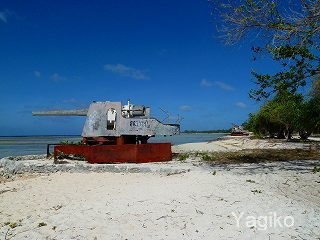
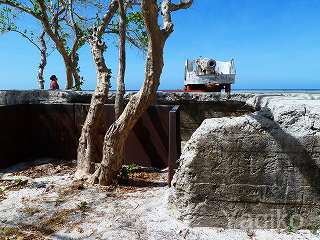
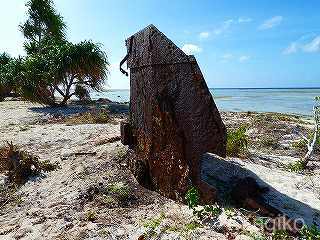
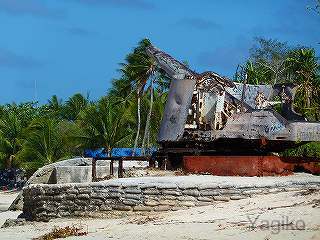
First,we visited battery relic located in eastern end of the island. The photo shows battery relic. It was faced in Southern direction towards the sea. Japanese army set up heavy armaments on the assumption that US army was likely to attack from the Southern direction then. Actual attack, as a matter of fact, was made from the Western to Northern shore with no use of these two batteries here, getting rusted now. It seemed to be rusted by time passing, but could not find any mark by attack on. Something similar to Box-shaped, made of concrete, may be base of battery.
We made memorial service here with recalling the dead relative, including my own grandfather. We prepared for the same desk as used on the 1st day and put some offering and incent sticks on.
I poured Drinking water hand-carried with me to the sea after memorial service. This was what I decided to do since I made up my mind in participating in this memorial service tour. Here in Tarawa atoll, drinking water is running in short. Even if we dig the ground of atoll, drinking water never springs from underground. It depended on the rainy water only. People living here during the war time was ought to have had tough time securing the drinking water under the very hot and humid climate. At that time, Mrs. M was burning the letter addressed to her father near the old concrete building wrecked. According to her explanation, she wrote her own sentimental feeling for her father beyond her description in this letter, and I am sure her sincere feeling may be brought to her father in heaven.
Next destination is Betio Memorial Park for Peace in southern Tarawa Island, where we are going to hold memorial service. It is said that Head quarter and lodge of Sasebo No. 7 Landing forces was located there. We held memorial service in front of the monument of war dead. Even if it is called as Memorial Park for Peace, its site was so small, and there was nothing but antiaircraft gun and monument, and inside the site covered by fence, there found monument, built by bereaved family of war in Marshal Islands area in 1982. Maria Kannon (the Goddess of Mercy) statue having the cross on back was built in direction of the North-West, towards Japan. At the same site, monument built by Korean bereaved family of war was there as well. In Tarawa Island, not only Japanese soldiers, but many Koreans called for the army civilian employees or tail were also dead.
Each member put their own hand-carried offering on the lower alter just in front of the memorial service desk, and after Mr. Y, as Tour leader, addressed the word of Memorial service and Mrs. K, as the representative of the bereaved family of war, made memorial speech, each member offered Japanese Incent sticks person by person. In this memorial service, other than our tour members, Mr. A, Japanese local supporter, and the Japanese society club in Kiribati, and JICA staffs working there joined to participate, in total 6 persons. They were very kind to come as they heard memorial service tour group was coming.
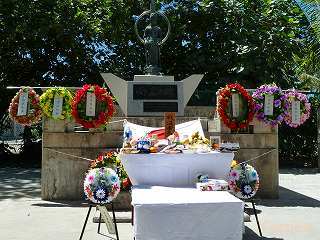
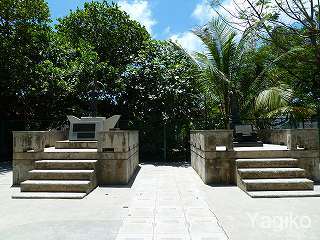
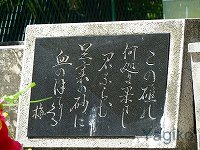
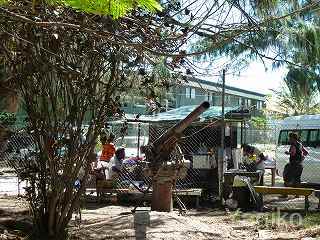
It is just a little hard to identify through photos, but behind the red-colored wreath on the right side, there found the monument engraving the poem written by Mrs. Umeko Shimosato.
"Somewhere around this atoll, you died, where? I feel my blood very hot even at the bottom of my feet on the sand in seashore."
Her husband was said to die in Tarawa Island. All of the members may have the same feeling as what she described in this poem. After fierce battle fight was over, sea was said to be colored red by blood of the casualties and dead soldiers of both U.S and Japan. Forever, it would not be clarified at all where and who died here.
There was wrecked antiaircraft gun standing in vein inside fence just outside the monument. And just behind over there, local native people in Kiribati is leading their daily life. What do they think of us while watching such memorial service? We are, no doubt, the bereaved family of war. We lost our beloved family during the war, and this sorrow can never be healed. We are, however, both assailant in this country here, Japanese as offense, as well as Americans as counter-attacker fighting back against Japan. For the local native people, their homeland was invaded by the third party and became battlefield with no choice, and lay in ashes. I feel very upset and small when I think so. When Japanese army decided to have Betio Island as major base, they removed local native people to other islands. I wonder if this was done from the military, strategic point of view. Thus there was the fact that native people was not got involved directly in its hell fight during the war. In addition, there was neither unlawful acts of violence, nor massacre by the Japanese army here. It is only one good news, isn't it?
